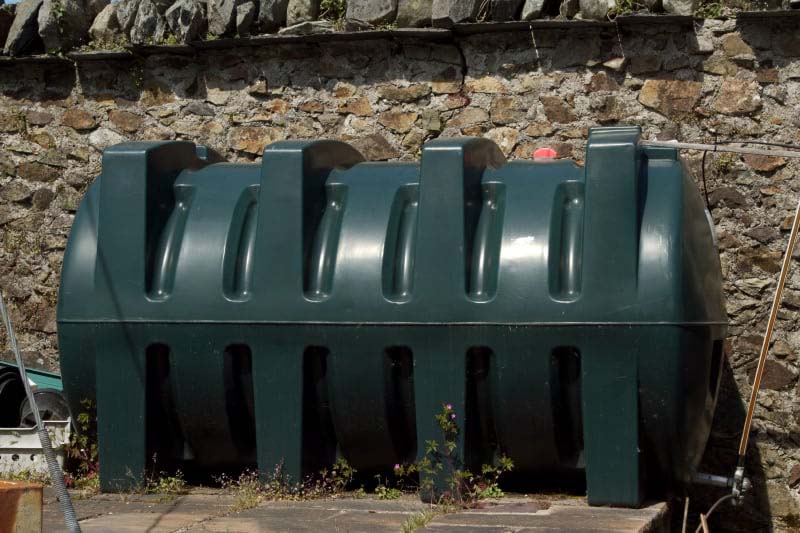Most domestic oil tanks last between 10 and 20 years, depending on the material, steel tanks typically last 15–20 years, while plastic tanks last around 10–15 years. Key factors that shorten life are corrosion, poor installation, and lack of maintenance, water contamination, and harsh exposure. Regular inspections, cleaning, and using quality fuel will help extend your tank’s serviceable life.
If your home relies on oil heating, one of the most important parts of your system is the storage tank. It safely holds your heating oil, ensuring a steady and reliable supply throughout the year. However, like all household equipment, oil tanks don’t last forever. Over time, they deteriorate due to weather exposure, corrosion, or age, leading homeowners to wonder, how long does an oil tank last?
In this detailed guide, we’ll explore everything you need to know about oil tank lifespan, factors that influence durability, signs of wear and tear, and how to extend the life of your oil tank to protect your investment and keep your heating running efficiently.
Understanding Oil Tank Lifespan
The lifespan of an oil tank depends on several factors, including material, installation quality, maintenance, and environmental conditions. Generally speaking:
- Steel oil tanks last around 15 to 20 years on average.
- Plastic (polyethene) oil tanks can last between 10 and 15 years, sometimes longer, with proper care.
However, these are general estimates. Some well-maintained tanks have lasted over 25 years, while poorly maintained ones may fail in under a decade.
To determine exactly how long your oil tank might last, you must consider its type, installation environment, and maintenance routine.
Types of Oil Tanks and Their Lifespan
There are two main materials used for domestic oil tanks, steel and plastic. Each has unique characteristics that influence its durability and performance.
Steel Oil Tanks
Steel oil tanks are known for their strength and resistance to physical damage. However, they are prone to rust and corrosion, particularly if exposed to moisture or salty air in coastal regions.
- Average lifespan: 15 to 20 years
- Advantages: Highly durable, can handle high impact, ideal for underground installation
- Disadvantages: Susceptible to corrosion, heavier, and more difficult to move or replace
To prolong their life, regular inspections for rust, cracks, or leaks are essential.
Plastic (Polyethene) Oil Tanks
Plastic tanks are becoming increasingly popular due to their lightweight design, corrosion resistance, and affordable price. They’re also easy to install and maintain.
- Average lifespan: 10 to 15 years
- Advantages: Rust-free, lightweight, UV-resistant coatings available
- Disadvantages: Can weaken or crack under prolonged sunlight or extreme cold
Modern plastic tanks often feature double-skin or bunded designs, adding extra protection and safety in case of leaks.
Factors That Affect How Long an Oil Tank Lasts
Several factors can influence your oil tank’s lifespan. Understanding these helps you make informed maintenance decisions and prevent costly replacements.
Material Quality
The type and quality of materials used in your tank’s construction have the biggest impact on its longevity. High-grade steel with protective coatings or UV-stabilised plastic will last significantly longer.
Installation
A poorly installed tank can lead to premature failure. Your tank must be placed on a stable, level base with proper support. Incorrect installation can cause uneven pressure, cracks, or leaks.
Environmental Exposure
Tanks exposed to harsh weather conditions, such as freezing temperatures, heavy rainfall, or direct sunlight, tend to deteriorate faster. Coastal locations can also accelerate rusting due to salty air.
Maintenance and Inspection
Routine checks for signs of corrosion, cracks, or sludge buildup are key. Annual inspections can catch problems early before they become severe.
Fuel Quality
Contaminated Oil can shorten your tank’s life by promoting microbial growth, sludge formation, or corrosion. Always buy from trusted suppliers like 123 Oil to ensure clean, high-quality fuel.
Tank Location
Indoor or sheltered tanks tend to last longer than those placed outdoors. If possible, position your tank in a shaded or partially enclosed area to reduce exposure to extreme weather.
Usage Frequency
Constantly filling and emptying your tank stresses its structure. On the other hand, leaving Oil sitting unused for long periods can lead to condensation and corrosion.
How to Tell If Your Oil Tank Needs Replacing
Even with regular care, oil tanks eventually reach the end of their lifespan. Recognising the warning signs early can prevent leaks, costly repairs, and environmental hazards.

Visible Rust or Corrosion
For steel tanks, rust spots are the first sign of deterioration. Corrosion weakens the structure and increases the risk of leaks.
Cracks or Bulging
Plastic tanks may warp or crack over time, especially when exposed to sunlight or fluctuating temperatures. Any distortion is a red flag that the tank is failing.
Oil Smells or Stains
Oil odours around your tank or dark patches on the ground may indicate minor leaks. These leaks can worsen quickly, leading to environmental contamination.
Sludge or Contaminated Oil
If you notice your boiler struggling or filters clogging more often, sludge buildup in your tank could be the cause. Excess sludge is a sign that your tank may be degrading from within.
Unstable Base
An uneven or sinking base can stress your tank’s structure, causing cracks or leaks over time.
Age
If your tank is over 15 years old, it’s time to start planning for replacement, even if it still appears fine. Regular inspections can confirm whether it’s still safe to use.
How to Extend the Lifespan of Your Oil Tank
You can take several practical steps to ensure your oil tank lasts as long as possible.
Regular Inspections
Have your tank professionally inspected at least once a year. A certified engineer can spot potential issues like weak seams, leaks, or rust before they become serious.
Keep It Clean
Sludge and condensation are common problems in oil tanks. Schedule periodic cleaning to remove residue that can lead to blockages and corrosion.
Monitor Oil Levels
Avoid running your tank dry, as this stirs up sediment and clogs filters. Keeping your tank at least one-third full also prevents condensation.
Install a Bunded Tank
A bunded oil tank features a secondary containment layer that catches leaks or spills, providing extra protection and extending tank life.
Shelter or Shade
Protect your tank from direct sunlight and heavy rain using a simple shelter or fencing. This reduces UV damage and moisture exposure.
Use High-Quality Oil
Fuel quality matters. Using premium or winter-grade heating oil helps reduce sludge formation and improve efficiency.
Check the Base
Ensure the base or stand supporting your tank is solid and level. Any movement or tilt can cause structural strain and eventual failure.
How Long Should 500L of Oil Last in the UK?
The lifespan of your oil tank isn’t just about the tank itself, it also relates to how long your oil supply lasts. Many homeowners ask, “How long should 500L of oil last in UK homes?”
The answer depends on several factors:
- Boiler efficiency: Older boilers use more fuel than modern condensing models.
- Home insulation: Well-insulated homes retain heat longer, reducing fuel consumption.
- Usage habits: Heating your home all day versus a few hours makes a big difference.
- Weather conditions: Colder months increase heating demand.
On average, 500 litres of heating oil can last anywhere from 4 to 8 weeks for an average UK household during the winter, depending on usage. In milder seasons, it may last much longer.
Efficient use, regular boiler servicing, and good home insulation can help stretch your fuel supply further and reduce heating costs.
Environmental and Safety Considerations
Oil tank leaks can cause serious environmental damage and costly clean-ups. That’s why it’s vital to keep your tank in good condition. Always check for any signs of Oil staining around the base or unusual odours.
UK regulations also require that domestic tanks over a certain capacity (typically 3,500 litres) or located near water sources meet OFTEC and Environment Agency standards. Installing a bunded tank or using approved installers ensures compliance and safety.
Proper disposal of old tanks is also important. When replacing your tank, have it decommissioned and removed by a licensed professional to avoid contamination.
Cost of Replacing an Oil Tank
The cost of replacing an oil tank varies based on size, material, and location. On average:
- Plastic tanks cost between £1,000 and £2,000, including installation.
- Steel tanks can range from £1,500 to £2,500 or more.
While replacement is an investment, it’s far cheaper than cleaning up a spill or dealing with a heating failure in the middle of winter.
When installing a new tank, ensure it complies with UK Building Regulations and is installed by an OFTEC-registered technician for safety and insurance purposes.
Why Regular Maintenance Matters
Neglecting your oil tank can drastically shorten its life. Regular maintenance ensures:
- Efficient performance of your heating system
- Lower risk of leaks or contamination
- Extended lifespan for your tank and boiler
- Better fuel efficiency and lower energy bills
Routine checks also ensure compliance with environmental and insurance standards, keeping your home safe and energy-efficient all year round.
Final Thoughts
An oil tank is a vital part of your home heating system, and knowing how long it lasts helps you plan for maintenance or replacement. Most tanks last 10 to 20 years, but their lifespan depends heavily on proper care, installation, and environmental factors.
By investing in regular inspections, keeping your tank clean, and choosing high-quality Oil, you can ensure it remains safe, efficient, and reliable for years to come.
When it comes to fuel quality and delivery, rely on trusted suppliers like 123 Oil, who provide premium heating oil and expert guidance to keep your system performing at its best.
Taking care of your oil tank today means peace of mind, efficient heating, and lower costs in the long run.
Frequently Asked Questions
Most domestic oil tanks last between 10 and 20 years, depending on the material, environment, and maintenance routine.
Rust, cracks, oil smells, bulging sides, and sludge buildup are common signs your tank is nearing the end of its lifespan.
Minor issues may be repairable, but if your tank is old or leaking, replacement is the safest long-term solution.
The duration is typically between 4 and 8 weeks, depending on home size, insulation, and heating usage.
Regular maintenance, inspections, cleaning, and the use of quality heating oil all help extend your tank’s lifespan.










